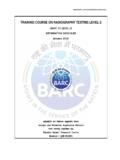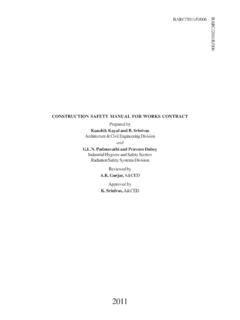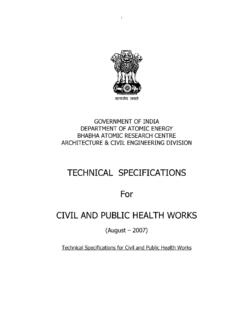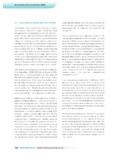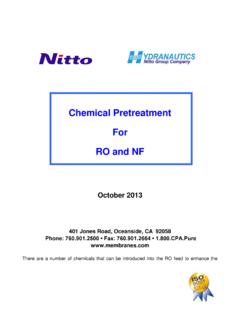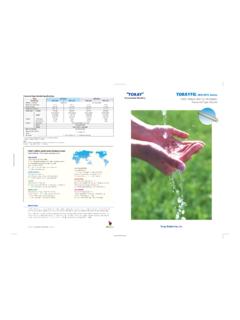Transcription of Composite Polyamide Reverse Osmosis (RO) Membranes ...
1 ISSUE NO. 321 I JULY - AUG. 2011 I 43 BARC NEWSLETTERTECHNOLOGY DEVELOPMENT ARTICLEC omposite Polyamide Reverse Osmosis (RO) Membranes Recent Developments andFuture DirectionsIntroductionReverse Osmosis (RO) membrane technology is oneof the mature separation technology tools used invarious industries for separation either as unitseparation process or as combination with otherprocesses. The productive RO membrane shouldoffer simultaneously high solute rejection, waterpermeability, chemical stability and good chlorineresistance particularly for aqueous acetate and aromatic Polyamide group ofpolymers are known as two best polymer materialsfor Reverse Osmosis (RO) applications till date [1].Cellulose acetate (CA), cellulose triacetate (CTA) andcellulose acetate-cellulose triacetate blend (CAB) Membranes are prepared generally in asymmetricform and hence give relatively lower flux comparedto the new generation thin-film Composite (TFC) Membranes .
2 In addition, CA based Membranes aresusceptible to microbiological attack, undergocompaction at higher pressures, and limitedchemically stability. On the other hand, polyamidemembranes exhibit more flux at a given appliedpressure, less microorganism susceptible and aremore stable over a wider range of pH values thanCA Membranes . Thus, Polyamide TFC membranesare currently the most widely used desalinationmembranes. TFC-RO Membranes comprise of ultra-thin Polyamide film formed in situ bypolycondensation reaction of polyfunctional amineand acid chloride monomers over a porouspolysulfone support membrane [2]. However, theirpoor chlorine tolerance (chlorine is inexpensive andeffective biocide widely used in water pretreatment)constrains their life and performance characteristicsleading to stringent pretreatment requirements. Highfeed pressures applied for RO applications damagepolymeric Membranes internally due to physicalcompaction of the porous support membrane andhence irreversible, internal fouling remains a seriousconcern for RO Membranes till date.
3 Apart fromthe internal fouling, surface fouling due Ghosh, Bindal, S. Prabhakar and Desalination DivisionAbstractThin Film Composite Polyamide (TFC-PA) are commonly used Reverse Osmosis (RO) Membranes inwater desalination and waste water applications. Their poor chlorine tolerance and fouling characteristicsconstrain the life and performance leading to stringent chemical pretreatment requirements. In thiscontext, development of fouling resistant and chlorine tolerant RO Membranes would be relevant toreduce the cost of pretreatment in aqueous based separations. In this article, we briefly review thecommercially available polymeric RO Membranes and then discuss our views on current proposals forfouling resistant RO Membranes mostly based on nano- Composite material chemistry. In addition,development of similar RO Membranes in Desalination Division, BARC is also : Polyamide , Composite membrane , Reverse Osmosis , fouling resistant, chlorine resistant44 I ISSUE NO.
4 321 I JULY - AUG. 2011 BARC NEWSLETTERTECHNOLOGY DEVELOPMENT ARTICLES trategies for synthesis of high fluxfouling resistant and chlorine resistantpolyamide membraneMore than 30 years, water flux and solute rejectionof Polyamide TFC Membranes have continuallyimproved but still these Membranes are not foulingresistant. Internal fouling due to compaction canbe managed to certain extent if macrovoids insupport membrane can be lesser number and/or byusing higher molecular weight polymer. Similarly,organic and biofouling resistant membrane needsto be such that the foulants should not attach tothe surface of the membrane easily. In most of thestudies so far, only one type of fouling can be solvedat a time. For example, if higher molecular weightpolymer is used, internal fouling due to compactioncan be solved by certain extent but it does not givesurface fouling resistant Membranes . On the otherhand, in surface functionalization by chemicalmodification of polymer to get surface foulingresistant membrane , chain breakage or degradationof polymer results in low compaction resistantmembranes.
5 Similarly, blending of functionalpolymer with base polymer can also used forpreparation of organic and biofouling resistantmembranes but very few polymers are compatiblewith commonly used membrane , concept of a mixed-matrix membrane (asmall filler material is dispersed throughout a largerpolymeric matrix) has brought new degrees offreedom to the development of advanced membranematerials with improved mechanical, chemical, andthermal stability, as well as enhanced separationcapacity [3]. And flux can also be increased by usingporous nanomaterials in mixed-matrix membranewhich opens a preferential flow path for pure waterto flow from the feed side to the permeate side ofthe preparation of chlorine resistant polyamidecomposite membrane , correlation between thechemical structure of polyamides and membranechlorine interaction need to be known. In case ofpolyamides synthesized from aromatic primarydiamines compounds, N-chlorination followed bychlorination of aromatic ring by OrtonRearrangement is responsible for changing chemicalproperty of Polyamide [4].
6 The Orton rearrangementtakes place only when amide linkage is directlyconnected with benzene ring (especially from amineside). Aliphatic polyamides, on reaction with chlorineyield N-chlorinated amide which can be regeneratedto the initial amide by treatment with reducing agent[4]. Tertiary polyamides are inactive towards oxidativechlorine. So, the strategies for better chlorineresistance are: (a) by protecting active sites onaromatic rings, (b) by synthesizing polymers withtertiary amide groups, (c) by incorporating aliphaticsecondary and tertiary amide linkage not directlyconnected with aromatic rings. Other thanpolyamides, polysulfone has much better chlorineresistance as it has chemically strong bonds betweencarbon, sulfur, and oxygen. But polysulfone ishydrophobic and hence RO types of membranecannot be prepared unless chemical structure ofpolysulfone is altered by introduction of controlledlevels of hydrophilicity while retaining its physicalproperties.
7 Sulfonated polysulfone has been reportedfor making nanofiltration (NF) and loose ROmembranes that are found highly tolerant to aqueouschlorine solution [5]. However, these are asymmetricmembranes and hence flux is expected to be lessscaling and deposition of organic materials,bioorganisms etc. also is a serious problem limitingthe life of RO Membranes . Hence development offouling and chlorine resistant RO membrane withbetter water flux is a thrust area of membraneresearch. In this article, we discuss the present statusof Composite Polyamide RO Membranes and futuredirection of research towards development of morefouling resistant and chlorine resistant ROmembranes keeping salt rejection and waterpermeability intact or better than the NO. 321 I JULY - AUG. 2011 I 45 BARC NEWSLETTERTECHNOLOGY DEVELOPMENT ARTICLED iscussionsPresent status in developments of thin filmcomposite (TFC) RO membranesThe present RO membrane market is dominated bythin film Composite (TFC) Polyamide membranesconsisting of three layers: a polyester nonwovenfabric act as structural support (~100 m thick), amicroporous interlayer support of polymer likepolysulfone (~ 40-50 m thick), and an ultra-thinpolyamide barrier layer on the top surface(~ m thick).
8 However, some of the otherpolymeric materials other than Polyamide also workas very good TFC RO Membranes . Table 1 showsdetails of some of the commercially available TFCRO Membranes and similar Membranes developedin our division in terms of polymer used as thin filmas well as membrane performance in RO testingcondition [2, 6]. The membrane preparationmachines used for TFC RO membrane making inFig. 1: Pictures of (a) support membrane castingmachine and (b) thin-film Polyamide coatingmachineTable 1: Details of the some of the commercially available TFC RO membranesRO membraneMaterialTesting conditionPermeate fluxSalt rejection(Pressure, Feed solution)(m3. m 2. day 1)(%)NS-200 Sulfonated polyfuran> 100 bar, > 69 bar, polysulfone> 69 bar, (aliphatic-aromatic)> 100 bar, (via polyepiamine)> 69 bar, > 100 bar, aromatic Polyamide > 15 bar, NaCl199 UTC seriesFully aromatic Polyamide > 15 bar, (aliphatic-aromatic) 10 bar, aromatic polyamide10 bar, that of TFC Membranes .
9 Some of thenanomaterials like carbon nanotube (CNT) can havecertain extent of chlorine tolerance and hence canbe embedded onto the membrane surface to makeit chlorine steps are shown in The processes andexact chemistries for producing most of thesuccessful commercially available RO membranes46 I ISSUE NO. 321 I JULY - AUG. 2011 BARC NEWSLETTERTECHNOLOGY DEVELOPMENT ARTICLEare still proprietary. A recent study substantiallyrevealed the physicochemical properties of some ofthe commercially successful RO Membranes [7]. Themembrane samples studied included two highpressure seawater RO Membranes (SWC4 andSW30HR) and six brackish water RO Membranes (LFC1, LFC3, ESPA3, LE, XLE, and BW30). Membranes SW30HR, BW30, LE, and XLE are DowFilmTec (Minneapolis, MN, USA) membrane andSWC4, LFC1, LFC3, and ESPA3 are Hydranautics(Oceanside, CA, USA) membrane . It was found thatthe uncoated fully aromatic RO Membranes hadsurface elemental compositions very close to thepredicted values for Polyamide based on the classicalinterfacial polymerization chemistry of meta-phenylenediamine and trimesoyl chloride but thecoated Membranes had higher oxygen and lowernitrogen content.
10 The presence of -OH groups incoating layer was further confirmed by highresolution XPS scans. Streaming potentialmeasurements showed the zeta potential of coatedmembranes was significantly less negative than thatof uncoated ones, consistent with ATR-FTIR and XPSresults. The uncoated Membranes are ESPA3, SWC4,LE, XLE and probably the polyvinyl alcohol (PVA)coated Membranes are LFC1, LFC3, BW30, andSW30HR. So far the best commercially successfulTFC Polyamide RO membrane has the ultra-thinbarrier layer made of cross-linked aromatic polyamideprepared via interfacial polymerization of meta-phenylenediamine and trimesoyl chloride (as givenin Fig. 2). From Table-1, it can be seen that BARC-TFC1 and BARC-TFC2 are typically brackish waterRO Membranes . BARC-TFC2 membrane that isprepared using meta-phenylenediamine - trimesoylchloride system gives better flux Membranes withhigher salt rejection than that of prepared usingpolyethylene imine (PEI) isophthaloyl chloride (IPC)system (BARC-TFC1).
